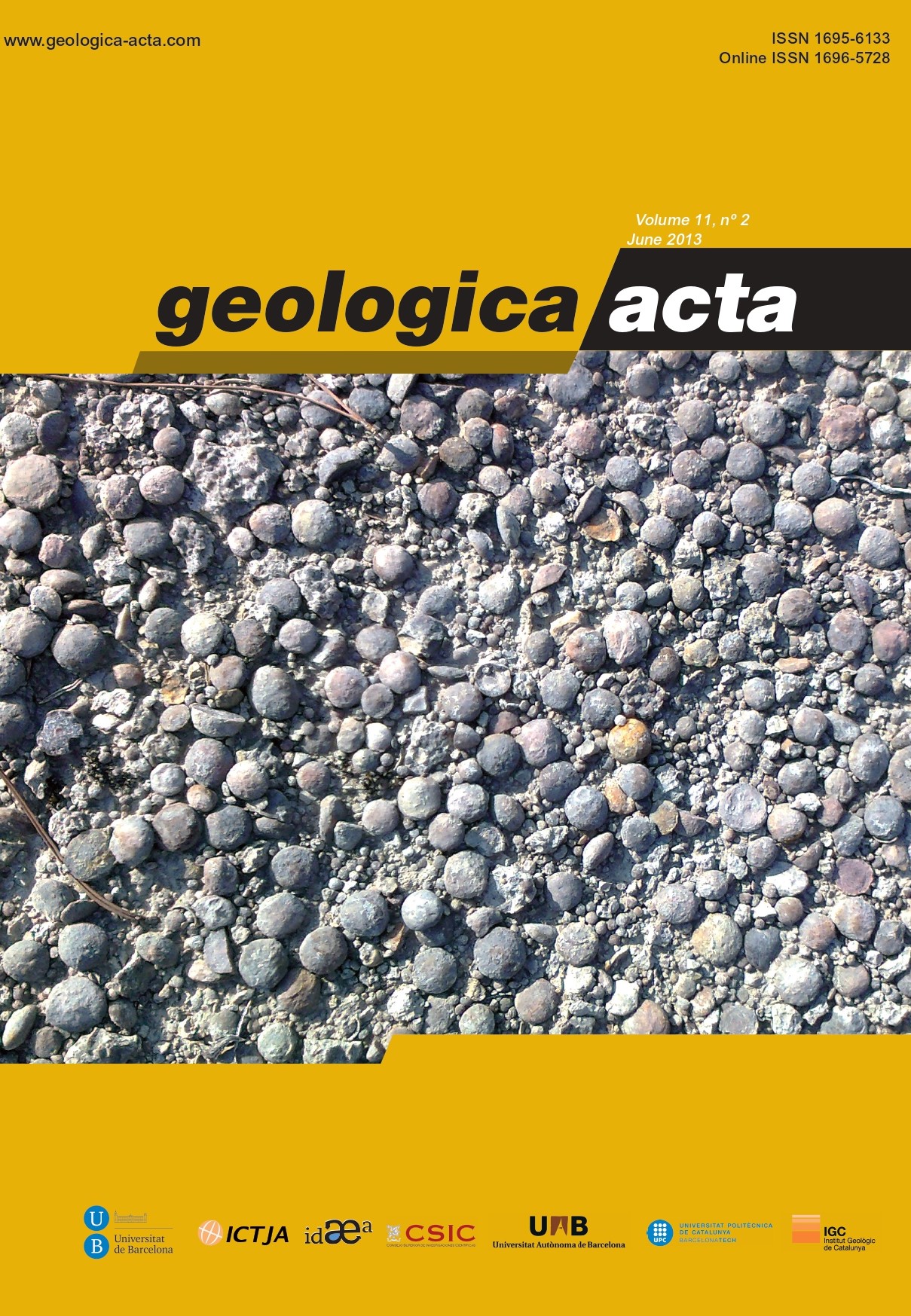Potential rockfalls and analysis of slope dynamics in the Palatine archaeological area (Rome, Italy)
DOI:
https://doi.org/10.1344/105.000001834Keywords:
Rockfall, Slope dynamics, Cultural heritage, Palatine Hill, Rome, ItalyAbstract
The Palatine Hill is among the main archaeological sites of Roman antiquity. Today, this place requires continuous care for its safeguarding and conservation. Among the main problems, slope instabilities threaten the southwestern border of the hill flanked by the Velabrum Valley, as also testified by historical documents. The upper part of the investigated slope is characterized by Middle Pleistocene red-brownish tuffs known as “Tufo Lionato”. The rock mass is affected by two jointing belts featuring the slope edge and its internal portion with different joint frequency and distribution. The analysis of the geometric relationship between the joint systems and the slope attitude evidenced possible planar sliding and toppling failure mechanisms on the exposed tuff cliffs. Potential rock block failures threatening the local cultural heritage were contrasted with preliminary works for site remediation. In addition, stress-strain numerical modelling verified the hypothesis of a tensile origin for the jointing belts, suggested by fracture characteristics and orientation. A first modelling was limited to the southwestern edge of the Palatine Hill and analysed the present stress-strain condition of the slope, proving the inconsistency with the observed deformation. A second modelling was extended to the Palatine-Velabrum slope-to-valley system to consider the role played by the geomorphological evolution of the area on the local slope dynamics during the late Pleistocene-Holocene. Results demonstrate how original conditions of slope instability, deformation and retreat along the Palatine western edge were determined by deep valley incision, and controlled by deformability contrasts within the slope. Slope instability influenced the site occupation and development during the Roman civilization, as also indicated by the remnants of retaining walls of different ages at the slope base.
References
Ambrosini, S., Castenetto, S., Cevolan, F., Di Loreto, E., Funiciello, R., Liperi, L., Molin, D., 1986. Risposta sismica dell’area urbana di Roma in occasione del terremoto del Fucino del 13-1-1915. Memorie della Società Geologica Italiana, 35, 445-452.
Álvarez, W., Ammerman, A.J., Renne, P.R., Karner, D.B., Terrenato, N., Montanari, A., 1996. Quaternary fluvialvolcanic stratigraphy and geochronology of the Capitoline Hill in Rome: Implications for Archeology and glacial cycles. Geology, 24, 751-754. DOI: 10.1130/0091-7613(1996)
Barton, N., 1974. A review of the shear strength of filled discontinuities in rock. Norwegian Geotechnical Institute Publication, 105, 1-30.
Bianchi Fasani, G., Bozzano, F., Cercato, M., 2011. The underground cavity network of south-eastern Rome (Italy): an evolutionary geological model oriented to hazard assessment. Bulletin of Engineering Geology and the Environment, 70(4),
-542. DOI: 10.1007/s10064-011-0360-0
Bieniawski, Z.T., 1989. Engineering rock mass classifications: a complete manual for engineers and geologists in mining, civil and petroleum engineering. New York, John Wiley and Sons Publishing, 251pp.
Bozzano, F., Floris, M., Gaeta, M., Martino, S., Scarascia Mugnozza, G., 2005. Assetto geologico ed evoluzione per frana di rupi vulcaniche nel Lazio Settentrionale. Bollettino Società Geologica Italiana, 124, 413-436.
Bozzano, F., Martino, S., Priori, M., 2006. Natural and maninduced stress evolution of slopes: the Monte Mario hill in Rome. Environmental Geology, 50, 505-524. DOI: 10.1007/s00254-006-0228-y
Bozzano, F., Bretschneider, A., Martino, S., 2008. Stress-strain history from the geological evolution of the Orvieto and Radicofani cliff slopes (Italy). Landslides, 5, 351-366. DOI: 10.1007/s10346-010-0208-x
Carboni, M.G., Iorio, D., 1997. Nuovi dati sul Plio-Pleistocene marino del sottosuolo di Roma. Bollettino della Società Geologica Italiana, 116, 435-451.
Casagli, N., Tapete, D., Del Conte, S., Luzi, G., Fanti, R., Massaggi, S., Leva, D., 2010. Il monitoraggio satellitare e con radar da terra. In: Cecchi, R. (ed.). Roma Archeologia: interventi per la tutela e la fruizione del patrimonio archeologico. Milan, Mondadori Electa, 1st volume, 145-157.
Cavinato, G.P., Moscatelli, M., Stigliano, F., Mancini, M., Bianchi, L., Cavuoto, G., Cecili, A., Cinnirella, A., Corazza, A., Di Luzio, E., Di Salvo, C., Lacchini, A., Marconi, F., Moretti, M.I., Pagliaroli, A., Piro, S., Pennica, F., Vallone, R., Verrecchia, D., Zamuner, D., 2010. Assetto geologico ed idrogeologico del Colle Palatino - Valutazione delle pericolosità geologiche. In: Cecchi, R. (ed.). Roma Archeologia: interventi per la tutela e la fruizione del patrimonio archeologico. Milan, Mondadori Electa, 1st volume, 84-137.
Conato, V., Esu, D., Malatesta, A., Zarlenga, F., 1980. New data on the Pleistocene of Rome. Quaternaria, 22, 131-176.
Corazza, A., Lombardi., L, Marra, F., 2004. Geologia, idrogeologia e approvvigionamento idrico del Colle Capitolino (Roma,
Italy). Il Quaternario, Italian Journal of Quaternary Sciences, 17(2), 413-441.
Croci, G., Biritognolo, M., 1998. Studio della stabilità e interventi di consolidamento delle strutture archeologiche e delle pendici sud-ovest del Palatino. In: Giavarini, C. (ed.). Il Palatino. Area sacra sud-ovest e Domus Tiberiana, Rome, Center for Information on Security Trades Central (CISTEC) Publishing, 177-194.
De Angelis d’Ossat, G., 1956. La Geologia del Colle Palatino in Roma. Memorie descrittive della Carta geologica d’Italia, Servizio Geologico d’Italia, 32, 95pp.
De Rita, D., Funiciello, R., Corda, L., Sposato, A., Rossi, U., 1993. Volcanic Units. In: Di Filippo, M. (ed.). Sabatini Volcanic Complex. Consiglio Nazionale delle Ricerche (CNR), Quaderni della Ricerca Scientifica, Progetto FinalizzatoGeodinamica, Monografie Finali, 114(11), 33-79.
Faccenna, C., Funiciello R., Marra, F. 1995. Inquadramento geologico strutturale dell’area romana. In: Funiciello, R. (ed). La
geologia di Roma. Il centro storico. Memorie descrittive della Carta geologica d’Italia, Servizio Geologico d’Italia, 50, 31-47.
Funiciello, R., Giordano, G., 2008a. La nuova carta geologica di Roma: litostratigrafia e organizzazione stratigrafica. In: Funiciello, R., Praturlon, A., Giordano, G. (eds). La geologia di Roma. Dal centro storico alla periferia. Memorie descrittive della Carta geologica d’Italia, Servizio Geologico d’Italia, 80, 39-86.
Funiciello, R., Giordano, G., 2008b. Geological Map of Italy 1:50.000 scale, sheet 374 “Roma” and explanatory notes. Servizio
eologico d’Italia, Florence (Italy), Società Elaborazioni Cartografiche (S.E.L.CA.).
Griffith, A., 1920. The phenomena of rupture and flow in solids. Philosophical Transaction of the Royal Society of London, 221, 163-198.
Hoek, E., Bray, J.W., 1981. Rock Slope Engineering. London, The Institution of Mining and Metallurgy, 402pp.
Karner, D.B., Marra, F., Renne, P., 2001. The History of the Monti Sabatini and Alban Hills Volcanoes: Groundwork for Assessing Volcanic-Tectonic Hazards for Rome. Journal of Volcanology and Geothermal Research, 107, 185-219. DOI:10.1016/S0377-0273(00)00258-4
Katz, O., Reches, Z., Roegiers, J.C., 2000. Evaluation of mechanical rock properties using a Schmidt hammer. International Journal Rock Mechanics and Mining Science, 37, 723-728. DOI:10.1016/S1365-1609(00)00004-6
Itasca consulting group, 2011. FLAC 7.0. Sapienza University of Roma, Department of Earth Science: License 213-039-0127-
Mancini, M., Moscatelli, M., Corazza, A., Pagliaroli, A., Stigliano, F., Simionato, M., Tommasi, P., Cavinato, G.P., Piscitelli, S., Marini, M., Giaccio, B., Sottili, G., 2011. Assetto geologico, idrogeologico e geotecnico dell’area archeologica comprendente il Colle Palatino, i Fori e il Colosseo. In: Cecchi, R. (ed.). Roma Archeologia: interventi per la tutela e la fruizione del patrimonio archeologico. Milan, Mondadori Electa, 2nd volume, 28-51.
Markland, J.T., 1972. A useful technique for estimating the stability of rock slopes when the rigid wedge sliding type of failure is expected. Imperial College Rock Mechanics, Research Report, 19, 10pp.
Marra, F., Rosa, C., 1995. Stratigrafia e assetto geologico dell’area romana. In: Funiciello, R. (ed.). La geologia di Roma. Il centro storico. Memorie Descrittive della Carta Geologica d’Italia, Servizio Geologico d’Italia, 50, 49-118.
Marra, F., Carboni, M.G., Di Bella, L., Faccenna, C., Funiciello, F., Rosa, C., 1995. Il substrato plio-pleistocenico nell’area romana. Bollettino della Società Geologica Italiana, 114, 195-214.
Marra, F., Rosa, C., De Rita, D., Funiciello, R., 1998. Stratigraphic and tectonic features of the Middle Pleistocene sedimentary and volcanic deposits in the area of Rome (Italy). Quaternary International, 47-48, 51-63. DOI:10.1016/S1040-
(97)00070-0
Milli, S., 1997. Depositional settings and high-frequency sequence stratigraphy of the middle-upper Pleistocene to Holocene deposits of the Roman basin. Geologica Romana, 33, 99-136.
Molin, D., Ambrosini, S., Castenetto, S., Di Loreto, E., Liperi, L., Paciello, A., 1986. Aspetti della sismicita storica di Roma, Memorie Società Geologica Italiana, 35, 439-448.
Molin, D., Guidoboni, E., 1989. Effetto fonti, effetto monumenti a Roma: i terremoti dell’antichita a oggi. In: Guidoboni, E. (ed.). I Terremoti prima del Mille in Italia e nell’Area Mediterranea. Bologna, Storia, Geofisica Ambiente (S.G.A), 194-223.
Moscatelli, M., Pagliaroli, A., Mancini, M., Stigliano, F., Cavuoto, G., Simionato, M., Peronace, E., Quadrio, B., Tommasi, P., Cavinato, G.P., Di Fiore, V., Angelino, A., Lanzo, G., Piro, S., Zamuner, D., Di Luzio, E., Piscitelli, S., Giocoli, A., Perrone, A., Rizzo, E., Romano, G., Naso, G., Castenetto, S., Corazza, A., Marcucci, S., Cecchi R., Petrangeli, P., 2012. Integrated subsoil model for seismic microzonation in the Central Archaeological Area of Rome (Italy). Disaster Advance, 5 (3), 109-124.
Ottaviani, M, 1988. Proprietà geotecniche di tufi vulcanici italiani. Rivista Italiana di Geotecnica, 3, 173-178.
Pensabene, P., 1998. Sostruzioni dell’angolo SW del Palatino: analisi delle strutture murarie. In: Giavarini, C. (ed.). Il Palatino. Area sacra sud-ovest e Domus Tiberiana. Rome, Center for Information on Security Trades Central (CISTEC), 107-
Poole, R.W., Farmer, I.W., 1980. Consistency and repeatability of Schmidt Hammer rebound data during field testing. International Journal Rock Mechanics and Mining Science and Geomechanical, Abstract,17,167-71.
Sbarra, P., De Rubeis, M., Di Luzio, E., Mancini, M., Moscatelli, M., Stigliano, F., Tosi, P., Vallone, R., 2012. Macroseismic effects highlight site response in Rome and its geological signature. Natural Hazards, 62, 425-443. DOI: 10.1007/s11069-012-0085-9
Tertulliani, A., Riguzzi, F., 1995. Earthquakes in Rome during the past one hundred years. Annali di Geofisica, 38(5-6), 581-590.
Ventriglia, U., 2002. Geologia del territorio Comune di Roma. Provincia di Roma, Servizio Geologico, Difesa del Suolo, 13 fold map, 809pp.
Downloads
Published
Issue
Section
License

This work is licensed under a Creative Commons Attribution-ShareAlike 4.0 International License.
Copyright
Geologica Acta is the property of the UB, GEO3BCN, IDAEA and UAB. Geologica Acta must be cited for any partial or full reproduction. Papers are distributed under the Attribution-Share Alike Creative Commons License. This license allows anyone to reproduce and disseminate the content of the journal and even make derivative works crediting authorship and provenance and distributing possible derivative works under the same or an equivalent license.
Author Rights
Authors retain the copyright on their papers and are authorized to post them on their own web pages or institutional repositories. The copyright was retained by the journal from the year 2003 until 2009. In all cases, the complete citation and a link to the Digital Object Identifier (DOI) of the article must be included.
The authors can use excerpts or reproduce illustrations of their papers in other works without prior permission from Geologica Acta provided the source of the paper including the complete citation is fully acknowledged.




